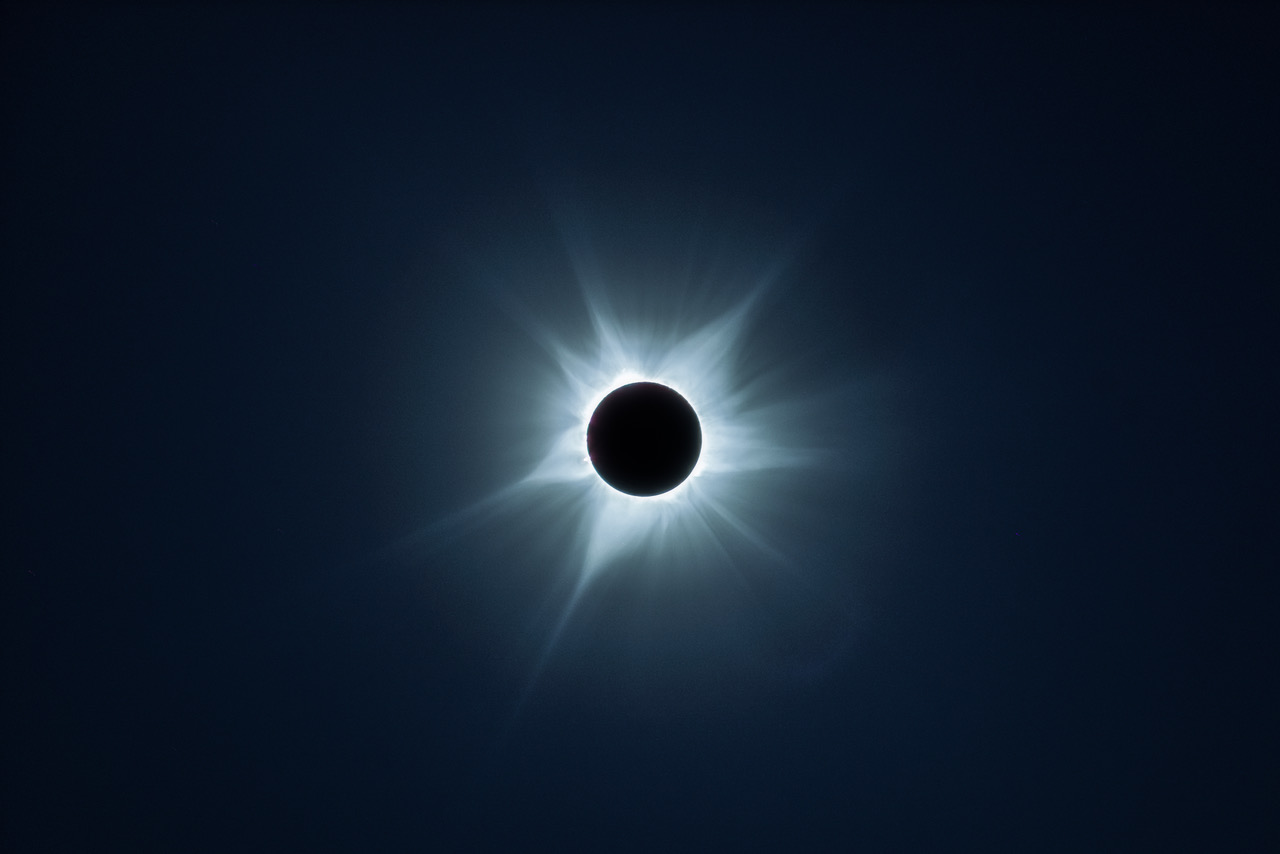The 2023 total solar eclipse, Australia
2023 June 7

On Apr 20, the Universe graced us yet again with one of the most awe-inspiring of events – a total solar eclipse. My son Peter and I made the 1,200km drive from Perth to the Exmouth Peninsula on the mid-west coast of Western Australia to find a heaving metropolis of ‘eclipse chasers’ from all over the planet. We had visitors from Brazil, the UK, the USA and continental Europe, among many others. There was a large Japanese contingent, in particular, accompanied by sophisticated telescopic and photographic rigs.
As it was our first total solar eclipse, anticipation was a mix of excitement and curiosity. What would totality actually be like? I had heard many stories of the transcendence of peace and calm, the effects on local wildlife (which in our case was mostly hominid in nature) and, of course, the magnificent and varied appearance of the solar corona and phenomena such as ‘Baily’s Beads’. None of these anecdotes could have prepared us for the event we were about to witness.
As part of a team of astronomy outreach volunteers organised by AstroTourism Western Australia, we were lucky enough to have been granted access to the premier viewing site south of the town of Exmouth, where we and the many local and international visitors and tour groups would be blessed with just under a full minute of totality under clear blue skies, with the Sun high above us.
First contact was just after 10am, which in itself was an astonishing sight. The Moon made its way slowly across the Sun, forming an ever-decreasing crescent shape that appeared almost artificially two-dimensional. This phase of the eclipse was, of course, gradual and predictable, requiring eye protection to view, and with camera lenses and telescope optics similarly protected. The illuminated world around us was noticeably changing from bright sunlight to the subdued tones of dusk and twilight.
The ingress phase of the eclipse lasted almost an hour and a half, with the 2,000+ in attendance socialising, eating, taking group photos, adjusting equipment, and occasionally monitoring the Moon’s progress. At a minute or so before totality however, the mood changed rapidly, with everyone securing their position for the final seconds.
My memory of totality, still vivid, is of a decline into the thinnest of thin crescents, followed by what could only be described as a sudden and explosive change. ‘BOOM’ – the light and air around us had been instantly sucked away, accompanied by a vocal exhale from the army of spectators nearby. With the blinding light of the Sun now gone, we quickly removed our solar glasses and equipment filters. There before us was a large and imposing black disc, a hole in the sky, very much in the foreground and seemingly within reach. All at once we could appreciate the fear and confusion that our ancient ancestors must have experienced. Behind this black disc appeared a translucent stream of coronal effects, dissipating in all directions against an indigo-coloured sky. Seemingly in motion, it included long, thin streams jutting out in every direction. Several prominences were erupting, and for those bold enough to avert their gaze, Jupiter and Venus were now also visible nearby.
We stood hypnotised in complete amazement, blindly hitting the shutter buttons on our cameras without taking our eyes off the sight before us. The 57 seconds or so of totality disappeared all too quickly, ejecting a sudden and short diamond-ring effect, and accompanied by a pressing need to quickly re-attach eye and instrument protection. Someone in the distance yelled out ‘come back’, and 2,000 people laughed and started to breathe again. My son and I looked at each other in bewilderment. Colourful language and expletives flowed (we are Australian after all) and we instinctively ‘high-fived’ one another while corroborating the details of what we had just witnessed in case one of us had been hallucinating.
For the next hour and a half, we continued to take periodic photos of egress, while sharing our collective experience with others and whimsically planning how we could all meet again in Texas for the next one in 2024. Eclipses, I had decided, were all about totality. Had we been bitten by the total eclipse bug?
Eventually the crowd started to pack up and move to their respective transports, remaining on a palpable high. The evening post-eclipse events provided time to share the experience, all of us trying to return to that moment of totality, where everything in the world around us had wondrously changed.
Since returning to Perth, I have struggled to process any of my photos in a way that truly represents what we witnessed, despite having achieved some impressively detailed images. I feel like Richard Dreyfuss’ character in the 1977 movie Close Encounters of the Third Kind, obsessed with trying to recreate an experience that cannot truly be conveyed unless you were there. I have stretched and fiddled with a couple of exposures to try and make them more like what we were actually seeing, but no amount of ‘mashed-potato sculpting’ has helped (with apologies to those that have not seen the movie).
The experience was, without doubt, both spiritual and scientific. If I was to lean towards one of those it would most definitely be the spiritual. Totality had been a mere minute or so, but its effect and memory will last a lifetime.
Paul Luckas
BAA & University of Western Australia
https://britastro.org/wp-content/uploads/2023/06/eclipse_19cm.tif
https://britastro.org/wp-content/uploads/2023/06/Process_1.jpeg
| The British Astronomical Association supports amateur astronomers around the UK and the rest of the world. Find out more about the BAA or join us. |
